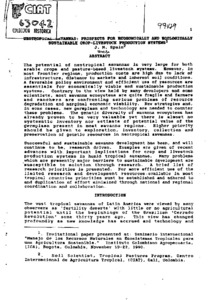Neotropical savannas: prospects for economically and ecologically sustainable crop-livestock production systems
The potential of neotropical savannas is very large for both arable crops and pasture-based livestock systems. However, in most frontier regions, production costs are high due to lack of infrastructure, distance to markets and inherent soil conditions. A favorable policy environment and efficient use of resources are essentials for economically viable and sustainable production systems. Contrary to the view held by many developers and some scientists, most savanna ecosystems are quite fragile and farmers and ranchers are confronting serious problems of resource degradation and marginal economic viability. New strategies and, in some cases, new germplasm and technology are needed to counter these problems. The genetic diversity of savanna ecosystems has already proven to be very valuable yet there is almost no systematic inventory nor estimate of potential value of the germplasm present in most savanna regions. Higher priority should be given to exploration, inventory, collection and preservation of genetic resources in neotropical savannas. Successful and sustainable savanna development has been, and will continue to be, research driven. Examples are given of recent advances with important implications for crop and livestock production systems in humid tropical savannas. Many problems which are presently major barriers to sustainable development are susceptible to solution through research. A brief list of research priorities is presented. For more efficient use of the limited research and development resources available in most tropical countries priorities must be established and adhered to and duplication of effort minimized through national and regional coordination and collaboration.

